But “The New Life” has an interest of another sort, and a claim, not yet sufficiently acknowledged, upon all who would read the “Divina Commedia” with fit appreciation, in that it contains the first hint of the great poem itself, and furnishes for it a special, interior, imaginative introduction, without the knowledge of which it is not thoroughly to be understood. The character of Beatrice, as she appears in the “Divina Commedia,” the relation in which the poet stands to her, the motive of the dedication of the poem to her honor and memory, and many minor allusions, are all explained or illustrated by the aid of the “Vita Nuova.” Dante’s works and life are interwoven as are those of no other of the poets who have written for all time. No other has so written his autobiography. With Dante, external impressions and internal experiences—sights, actions, thoughts, emotions, sufferings—were all fused into poetry as they passed into his soul. Practical life and imaginative life were with him one and indissoluble. Not only was the life of imagination as real to him as the life of fact, but the life of fact was clothed upon by that of imagination; so that, on the one hand, daily events and common circumstances became a part of his spiritual experience in a far more intimate sense than is the case with other men, while, on the other, his fancies and his visions assumed the absoluteness and the literal existence of positive external facts. The remotest flights of his imagination never carry him where his sight becomes dim. His journey through the spiritual world was no less real to him than his journeys between Florence and Rome, or his wanderings between Verona and Ravenna. So absolute was his imagination, that it often so far controls his reader as to make it difficult not to believe that the poet beheld with his mortal eyes the invisible scenes which he describes. Boccaccio relates, that, after that part of the “Commedia” which treats of Hell had become famous it happened one day in Verona, that Dante “passed before a door where several women were sitting, and one of them, in a low voice, yet not so but that she was well heard by him and his companion, said to another woman: ’See that man who goes through Hell and comes back when he pleases, and brings news of those who are down there!’ And then one of them replied simply: ’Indeed, what you say must be true; for do you not see how his beard is crisped and his face brown with the heat and smoke of it?’"[2]
From this close relation between his life and his works, the “Vita Nuova” has a peculiar interest, as the earliest of Dante’s writings, and the most autobiographic of them in its form and intention. In it we are brought into intimate personal relations with the poet. He trusts himself to us with full and free confidence; but there is no derogation from becoming manliness in his confessions. He draws the picture of a portion of his youth, and lays bare its tenderest emotions; but he does so with




